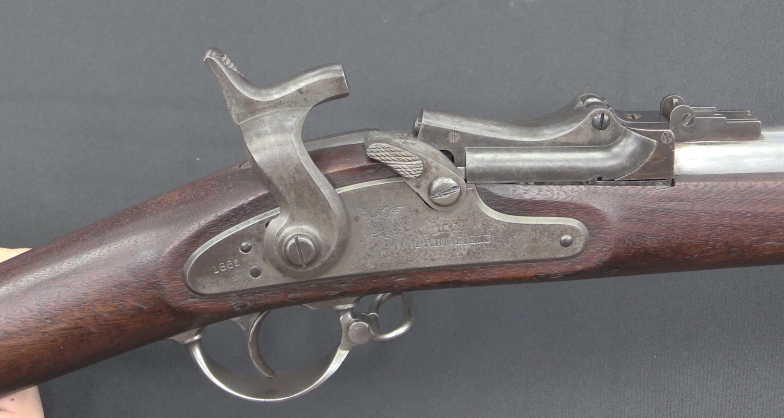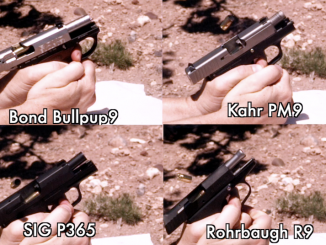This two-stamp transferrable Colt 639 is being sold at Morphys on October 30, 2018.
The Colt Model 639 was the export version of the Colt Model 629, which was type classified by the US military as the XM177E2 and issued to MACVSOG special operations units in 1967 and 1968. Improved from the Model 609 carbine, the 629/639 has an 11.5 inch barrel and an interesting small muzzle device (“moderator”) which served to change the signature of its firing to sound much more like an AK type rifle than an M16. The device does that job well – at least until it had been fired extensively, which slowly fills up the (non-disassemblable) unit with carbon and powder residue, substantially reducing its effectiveness. It has a full-fence lower, standard carbine buffer and spring, and a two position aluminum collapsing stock. It is the iconic weapon of US special forces in Vietnam.
Only about 100 of the Model 639 were made in the early 1970s, and many of those were sent back to Colt in 1975 under a recall. At that time, the ATF decided to classify the muzzle device as a silencer, prompting Colt to recall the guns and remove and destroy the devices. Some owners, however, kept their carbines and instead registered the muzzle devices, allowing them legally remain on the guns.




This HTML-5 format video does not play on my computer.
Would you issue it in your normal format?
Thank you.
Eric.
Which browser did you tried?
Were they up to date?
Do you use any script blocker?
I use FireFox.
latest version which works with my computer.
No script blockers.
All of the other videos play just fine.
Only this particular one does not.
Thanks.
Since the Colt 639 has a full three-point magazine button wall, it can be considered part of the M4 evolution line.
Strange…
I also use this browser with some blocking plugins and it goes well.
Have you tried Brave, Opera, or another browser?
Firefox has always worked for Forgotten Weapons
so wondered why this one did not function.
Eric.
was first known as XM177E2 with 5 inch flash suppressor silver soldered on 13.5 inch barrel….heck of a flash …blinding at night used most often as Pilot weapon if shot down….trading got the shorter arm in to the hands of legs and ground pounders…Beanies had them fairly early…if you ever moved an M14 with mags in a B A R rifle magazine belt ( 260 rds ) through night patrols in dense brush, you would happily trade for the XM177E2..5 M16 3 magazine pouches ( 450 rds ) seemed to weigh less than the BAR belt
There’s a pretty good photo of then Sgt John Plaster holding one of these (and a beer) after returning from a mission. The promoted (and now retired) Major Plaster has written several excellent books about sniping, as well as a history and pictorial history of SOG, describing names, missions, weapons, etc. All of the team names were different tools, snakes or states, depending on whether they were in CCN, CCC, or CCS (Command and Control North, Central or South, depending on their AO).
My experience with these beasts is limited, but I suspect that the muzzle device was actually intended to alter the pressure curve and dwell-time in the gas system.
With such a short barrel,the port is very close to the action AND the muzzle. With a “bare” muzzle,or just a basic birdcage flash hider, having a bigger port to capture enough gas would be a challenge and lead to parts breakage. There was ONE standard ball round at the time, M-193, (propellant controversies aside) and thus a single,known pressure curve in a standard barrel.
Lopping the barrel and moving the port much closer to the action presented problems, especially with the “ultra-short” models.
The “muzzle device” is quite complex inside and serves to “flatten” the pressure curve to give a bit of extension to the “dwell time” port pressure, basically a mechanical, fluid-dynamics “integrator”.
And never mind the serious drop in muzzle velocity with such a short barrel.
Colt had been fooling around with different lengths in the mid 1960s and that is the origin of the familiar 14.5″ seen on later goodies. Nifty compromise; “shorty” hand-guard length, enough barrel length to support a standard bayonet and a standard flash-hider, not too much more flash and noise. Basically it seemed a bit silly to lop off lots of barrel and then extend it right back with a fancy muzzle gizmo.
See also recent ammunition developments to claw back the ballistic losses cause by going to that “intermediate” length.
You are factually correct, it was most likely pressure delay device, much like Krinkov. The blast is still quite formidable though; there are plenty of videos to prove that.
As it seems, 16″ barrel length for 5.56 Nato is most common with new rifles and is the best compromise. Fancy muzzle ends are not necessary.
I don’t know about that. The French bought their HK 416 rifles with 11.5″ and 14.5″ inch barrels, and even more of the former than latter. The US is, as far as I know, only buying M4s with its 14.5″ barrels. The program to replace the AR-15 derivatives with a new 6.8mm rifle has started, but it will be years before we will see results, and knowing US Army rifle procurement programs since the end of the Cold War, chances are that no new rifle will be ordered in the end… And in any case, current plan is that REMFs will continue to use M4 in 5.56mm NATO for self defense even after the new rifle has been adopted for infantry.
Good for French… their choice. Their GIGN security service is disposing of HK406 and replacing them with CZ807 in M43 (16 in barrel).
Most common rifle produced by Colt Canada has barrel length 15.7in/ 40cm (MRR medium).
Muzzle velocities for barrel lengths of 20, 16 and 14.5 inch with M855 are cca 3000, 2975 and 2930 ft/s.
There is not much velocity loss by 1.5in difference in length, but user surely feels the blast.
Hmm…. GIGN version of Bren2 has shorter barrel.
https://en.wikipedia.org/wiki/GIGN
But these rifles in service with Egyptian, Hungarian and other forces are with bbl 16in long as standard. Vz.58 was with bbl of 15.6 in long, just a tad shorter than AKM.
From what I’ve seen, the 14.5″ barrel is still the preferred length for military use. The 16″ barrel is mostly seen on US civilian carbines since that keeps the gun an NFA title 1 firearm that doesn’t have to be registered as a short barreled rifle. Some US market carbines retain the 14.5″ barrel and avoid NFA registration by using a permanently installed muzzle device to make the barrel 16″.
You really have to wonder what happened with the theorem of 20 in long barrel in order to achieve optimum terminal ballistics. No need for ‘tumbling’ I guess.
“what happened with the theorem of 20 in long barrel in order to achieve optimum terminal ballistics”
Remember that ammunition evolves too.
https://en.wikipedia.org/wiki/5.56%C3%9745mm_NATO#Mk318
They where pretty darn Cool…I Humped a sawed oFF M-79 for chits & giggles in ‘68
I was wondering why no mention was made of the tapered handguard retaining ring? That appears to be much newer than this gun – I don’t remember seeing them on the XM-177’s which were issued in the late 1970’s. Any idea about this?
The Colt 629 was one of the first AR15s with a tapered ring, actually. I’m not sure what THE first rifle with a slip ring was, but this is definitely the earliest I’m aware of.
“…was adopted….:
No it wasn’t, XM tells you it was never standardized and remained experimental. If it was standardized, it would have been the M177 – or maybe the M4 if it had been classified as a carbine, beating the current M4 by about three decades.
Thanks for bringing this up. I was going to say that but you beat me to it.